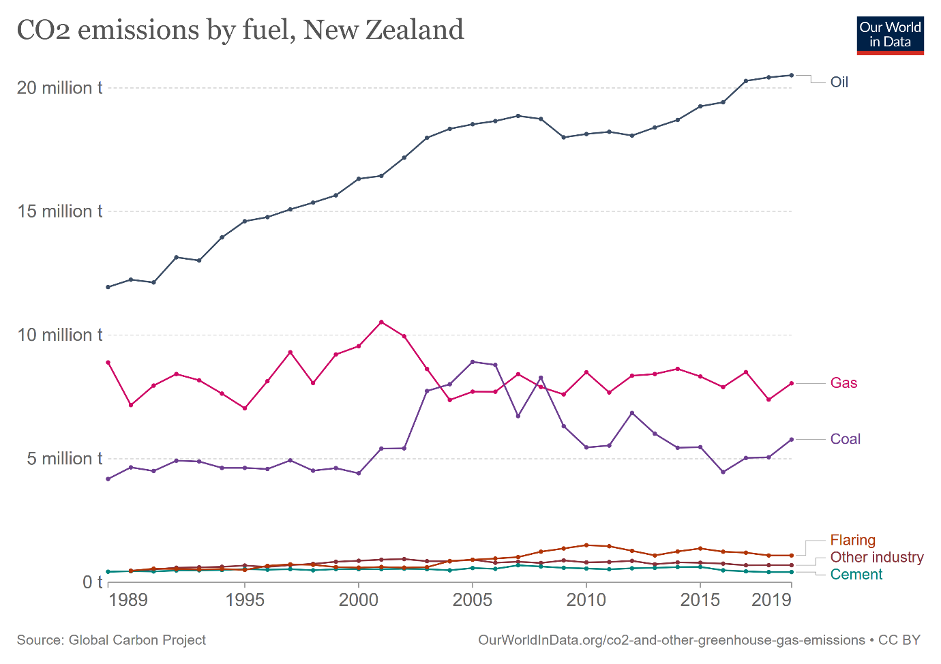What impact does New Zealand’s coal use have on the climate?
In 2019, emissions from coal accounted for about 7% of New Zealand’s overall greenhouse gas emissions[1].
What’s happened with New Zealand’s emissions since 1990?
Put simply, they’ve risen, much more than other developed nations. This is in part because unlike many developed nations, New Zealand has experienced relatively high population growth in the same period – about 42%[2].
This has, among other things, led to an increase in oil consumption due to greater demand for transport.
The country’s gross greenhouse emissions have risen about 26% since 1990[3].
Allowing for carbon dioxide that has been removed from the atmosphere through forestry planting gives us a rise in net emissions (the gross amount emitted minus the amount of CO2 removed through forest sequestration) of about 33%[4].
Trends for both net and gross emissions are shown in the graph below.
In terms of gross emissions, New Zealand’s total output of greenhouse gases in 2019 was 82,319,880 tonnes of carbon dioxide equivalent[5], or CO2e (CO2e is a unit that allows different greenhouse gases to be standardised and compared in equal terms).
The above graph shows increases in emissions of carbon dioxide, methane, and nitrous oxide since 1990[6].
From 1990 to 2019, New Zealand’s carbon dioxide emissions increased 46.8%, methane emissions increased 5.3%, and nitrous oxide emissions increased 45.3%, albeit from a lower base.
How does coal compare to other fossil fuels in terms of its contribution to New Zealand’s carbon dioxide emissions?
The increase in carbon dioxide emissions from fossil fuel use has been largely driven by oil (due to the use of its derivatives in transport), and to a lesser extent due to increased use of coal. Natural gas use has fallen.
The above graph, sourced from Our World in Data (the Ministry for Environment’s data doesn’t cleanly break down CO2 emissions by fuel) shows the trends for carbon dioxide emissions from fossil fuels since 1989 to 2019[7].
From 1990 to 2019, New Zealand’s emissions from oil are shown to have increased by 71%, emissions from natural gas have fallen 5.05%, and emissions from coal have risen 24%.
As the graph indicates, coal emissions (and consumption), are volatile year on year, largely due to the use of coal as a flexible source of energy for the electricity sector. In 2016, for example, coal emissions fell below the 1990 level, due to low demand from the electricity sector.
For both gas and coal, emissions have fallen on a per capita basis, whereas oil emissions have risen both in absolute terms and on a per capita basis.
In total, in 2019, oil accounted for 56.1% of New Zealand’s carbon dioxide emissions, natural gas 22.02%, coal 15.8%, and the other 6% came from flaring, other industry, and cement.
Coal consumption in New Zealand over past three decades by sector
As can be seen in the above graph[8], the volatility in electricity demand is what underpins a certain amount of variability in coal consumption and coal emissions. Outside of the electricity sector, coal use does shift year on year, but has been comparatively steady since 1990.
In New Zealand today, coal is used mainly in electricity generation, the manufacturing of steel and cement, and for food production.
What about emissions per capita?
New Zealand’s carbon dioxide emissions per capita are about middle of the pack compared with other developed nations, based on date for the 2020 year.
This selection of countries[9] above simply places Zealand in context with other advanced economies in the 2020 year.
For greater context, a 2020 OECD report ranked New Zealand (in the 2018 year) 18th out of 36 for carbon dioxide emissions[10].
But, if all greenhouse gases are included, New Zealand ranks much higher on a per capita basis, coming in 5th (in the 2017 year) highest behind Australia, the United States, Canada, and Luxembourg[11].
This is because of New Zealand’s high livestock numbers relative to the population of humans, meaning our methane emissions from agriculture are also high. New Zealand is one of few OECD nations where agriculture is the largest source of emissions -the only other OECD country that comes close is Ireland.
What can be done about New Zealand’s greenhouse gas emissions?
Emissions result from almost every activity carried out in a developed nation on a daily basis. New Zealand, much more than other advanced economies, relies heavily on agriculture for jobs and exports. Without economically viable factories to process our milk and red meat, it would be very difficult to stay competitive in international markets.
Transport also gets these goods to international markets and brings in international tourists and students.
If all gases and sectors are included, coal accounts for about 7% of New Zealand’s gross greenhouse gas emissions – not insignificant, but also, not the biggest source of emissions by any means.
Coal is also a necessary fuel within New Zealand’s electricity sector, for food production, and in the wider economy. It is ingrained in processes and systems, and there are few alternatives that could take its place within the limits of today’s technology.
The two alternatives for coal as an energy source most often put forward for in New Zealand are electrification and conversion to burning wood fuels – both of which have significant barriers preventing coal users across the board converting to either of these options.
Simply banning coal or restricting its use prior to actually having something else to take its place will do relatively little to reduce New Zealand’s greenhouse gas emissions but have a potentially massive impact on our industries that rely on it.
References
View the references page for this article here.




